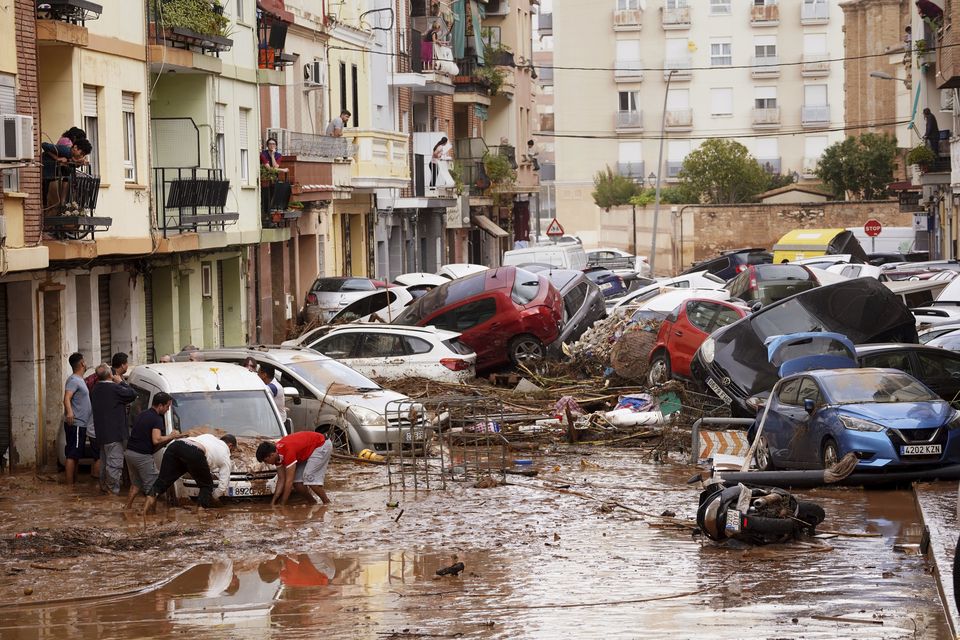At least 70 people have lost their lives in catastrophic flooding that has swept across Spain, primarily affecting the province of Valencia. The Integrated Operational Coordination Centre of the Interior Ministry confirmed the grim toll, compiling data from various security and emergency agencies. Early reports from Valencian authorities suggested a significant number of casualties.
The relentless weather phenomenon has left a trail of destruction, with dozens still missing. An 88-year-old woman perished in the town of Mira, Cuenca, while six individuals remain unaccounted for in Letur, Albacete. The Spanish Ministry of Defense has deployed portable morgues as fears grow that the clearing of mud-filled towns in Valencia may uncover additional victims. Aerial resources, military psychologists, and trained dogs have been mobilized to aid in the search.

Prime Minister’s Plea and Royal Condolences
Prime Minister Pedro Sánchez urged the public to remain vigilant as the severe weather persists. Countless individuals were stranded overnight, seeking refuge on rooftops, in vehicles, or on elevated ground.
King Felipe VI expressed deep condolences to the affected families and warned of the extensive damage to infrastructure and property. He acknowledged the challenges faced by authorities in reaching remote areas and reassured the public that all available resources were being utilized.
See also: Destructive hurricane leaves at least 51 dead
Herculean Rescue Efforts
The Valencian premier, Carlos Mazón, highlighted the immense difficulties encountered by rescue teams in reaching those in need. Firefighters, local police, and the Military Emergency Unit (UME) worked tirelessly, even as the Civil Guard faced its own challenges, with two agents missing.
Widespread Disruptions
The heavy rainfall has led to widespread power outages affecting 155,000 people and road closures across multiple eastern and southeastern provinces. High-speed rail services between Madrid and Valencia, as well as the Mediterranean corridor to Barcelona, remain suspended.
Storm’s Path and Impact
The storm is currently moving northward, impacting the eastern and southeastern regions. The interior of Valencia province has borne the brunt of the heavy rainfall, resulting in numerous road closures. Similar conditions have been reported in Teruel, Andalusia, and Castilla-La Mancha, with rail services also disrupted.
Social Media’s Role
Videos circulating on social media, depicting the force of the water and the plight of stranded individuals, have both shocked and aided rescue efforts. These visual records have helped locate those in distress and guide the actions of security forces.
Gota Fría’s Devastating Force
The extreme weather event is attributed to the “gota fría,” or “cold drop,” a phenomenon characterized by a sudden temperature drop along the east coast due to the arrival of cold polar air. The current cold drop in Valencia is considered one of the most severe of the 21st century, comparable to those experienced in 1987 and 1982.
Aviation and Rail Disruptions
Spain’s air traffic control manager, Enaire, reported the diversion of 30 flights at Valencia airport and 19 at Madrid-Barajas. Adverse weather conditions have led to flight disruptions and delays at various airports across Spain, including Valencia, Madrid, Barcelona, Alicante, and Málaga.
European air traffic has also been affected, with delays and cancellations at London Heathrow, German airports, Zurich, Brussels, and Paris.
Renfe, Spain’s state-owned rail company, has suspended most rail services in Valencia, including high-speed connections to Madrid and Seville. Long-distance and medium-distance services on various routes have also been halted. Additionally, five lines of the Cercanías commuter network in Valencia remain suspended.
Locally, both Pilar de la Horadada and Orihuela have cancelled their upcoming parades and festivities to celebrate Halloween in solidarity with the flood victims. Valencia has also declared 3 days of official mourning throughout the whole of the community.





